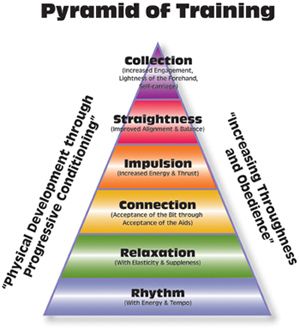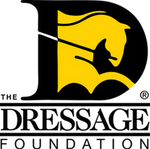Michael Poulin’s Thoughts on Training a Horse to Grand Prix

About Michael: Most people who reach the highest levels in dressage make their mark in one primary facet of the sport - competitor, trainer, instructor, judge. Michael Poulin is all four. He is a member of the Bronze Medal winning United States Team at the 1992 Barcelona Olympics, and boasts multiple national and international championships. Michael heads the Poulin School of Dressage at the Dressage Center, Inc. in DeLeon Springs, FL, where he works with a prominent student roster.
This article gathers some of Michael’s thoughts on classical riding to Grand Prix.
Foreword: Congratulations on choosing dressage as your discipline. As you know, dressage is designed to make a better riding horse, not necessarily a better competition horse, although if you do the correct training on the ground from the beginning, you will be a very happy rider.
On training a horses: I work a young horse from the ground for several months before I get on him for the first time. By working from the ground, you can eliminate the horse’s fear and anxiety because you are teaching the horse commands that he can easily understand. This gives the horse more confidence in the work. Learning to long line will be one of the most valuable tools for your future Grand Prix horse. Once he has developed balance and strength from this approach, you will have already made a major leap forward in the understanding of what will be asked for in later development.
The value of training a horse at the speed that he can learn is always the best. By training at the horse’s pace, you will create confident advancement in the horse. If you train a horse to do something within ‘X’ number of days, forcing the issue, you will create restrictions within the animal that promote the slow deterioration of his movement, and he may never become a top horse. Not all horses are going to be top Grand Prix horses, so don't expect too much from horses that have limitations.
On finding a coach: I would highly recommend getting a coach who will take on the problems of the student, rather than create them. A good coach is someone who has a track record of being kind and confident; with a proven system and methodology that shows itself in the arena. The student should be able to easily understand the steps to take in the training. Even if you have to travel a great distance to find the right coach for you, do that. Take the time to find a coach who will support you.
I would caution you towards any trainer, coach or teacher that uses inappropriate language, creates negatives in your learning process or doesn't have the answers for your questions. That is someone you do not want to spend your time with. Pick a trainer who has a good knowledge base and riding background. There are many trainers who can start something but have very limited knowledge on how to develop it. When the pitfalls come, the coach will not see them, and your horse will learn to resist in an incorrect way, hurting the animal and your future. It's a lot like a flying instructor teaching you how to get the airplane off the ground, but never teaching you how to land it.
On gaining experience as a rider: I cannot stress this point enough - if you want to be a top rider, you will need lots of experience on an FEI horse. If you don’t have the money to buy or lease an FEI horse, be a working student for someone who does. Riding is feeling, and if you don't know the feeling, you won’t be able to apply that feel to a young horse. Do lots of reading about what you are to look for while training and why. Remember that you're supposed to develop the horse’s gaits - not diminish them.
Historically, many horses do well until Third Level, but when it comes to the upper levels, there are very few that make Grand Prix. This can be due to the lack of correct training towards that individual horse at an early age. You should learn the training scale and know how to explain the value of all six individual parts, so when you look at a horse, you can see if the basics are clearly in place. Remember it takes a lot of time to develop a good upper level horse.
Rhythm – Clear footfalls at each gait or beat. Walk is 4-beat, trot is 2-beat, canter is 3-beat. Maintain tempo within these gaits.
Relaxation – Absence of tension, physically and mentally.
Contact – Acceptance of the bit through the acceptance of the feet, leg, and rein aids.
Impulsion – Increased energy, thrust, and suppleness generated from the hindquarters through to the bit.
Straightness – Correct alignment on both straight and curved lines. Note the footfalls on the diagrams.
Collection – Increased activity from behind and a lightness of the forehand.
Don't be afraid to ask questions along your training journey. Most people who are very successful like to speak about how and why their training programs work, and some even share what mistakes they made. There is a tremendous amount of knowledge on the internet, but there's nothing more helpful than working with a coach or trainer who has trained many horses to Grand Prix and dealt with problems within the training process. I would highly recommend going and spending some time with someone who has trained horses up to Grand Prix, so you can actually see the process in action. This is also useful because you can get a feel for the temperament and demeanor of your coach.
Your seat is going to be a VERY important part of your future, so make sure you work on it every day! If you can't follow the rhythm and stay in balance with your horse, you can't be creative with your seat, your legs or your hands. Don’t underestimate the value of having a good seat! It is absolutely vital.
On choosing a horse: A big key to successful training is picking your horse. You can first start to understand breeding by looking at the history of Olympic horses. Who were the sires and the dams? Did they do dressage and how successful were they?
When I look for a horse, I ask:
1. What is the horse’s temperament?
2. What is its character?
3. Is the horse intelligent?
4. Is the horse aware of its surroundings?
5. Does it respond to sound quicker than sight?
6. Is it a looker? Does the horse spook at everything?
For me, I don't want to fight with the horse every day to get by the same spot on the ground. It’s not fun having to work around that for years and it slows the process of learning. It can be fixed in time but it's a lot more work.
Everyone wants three good gaits in a horse. For me, the canter is the most important. The walk has to have four clear beats and should not be too big. A huge walk is difficult to keep clear as you enter collection. A quick hind leg is a must. And remember, the trot can be developed much easier than the canter. Don’t ever pick a horse by its color!
End note: Classical knowledge is imperative to classical riding. The philosophy of classical riding is that the horse understands the rider's aids with relaxation - not fear - and relates the aids to the physical movement that he's doing. Classical riding develops the horse’s physique with mental understanding.
